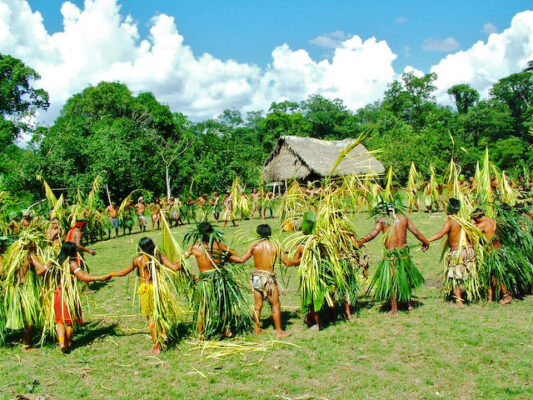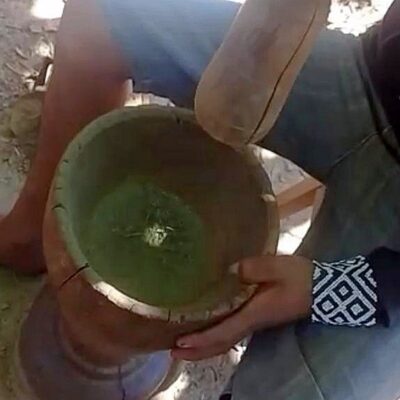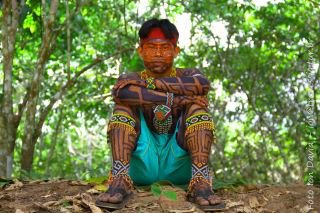“The shaman gives and takes life. To become a shaman, you go alone into the forest and wrap your entire body in embira. You lie down at an intersection with your arms and legs outstretched. First come the night butterflies, the husu, who completely cover your body. Next comes the yuxin who eats the husu until reaching your head. Then you grab him tightly. He transforms into a murmuru palm, which is covered in spines. If you’re strong enough and don’t let go, the murmuru transforms into a snake, which wraps around your body. If you keep hold, he transforms into a jaguar. You continue holding him. And this continues until finally you’re left holding nothing. You’ve won the ordeal and you can speak: you explain that you want to receive muka and he gives it to you.” [Siã Osair Sales]

The Huni Kuin are one of the indigenous peoples who live in the Brazilian and Peruvian Amazon, speaking the Pano language and with a long cultural history of ayahuasca and sacred snuff usage.
Huni Kuin means “true people” or “people with traditions” in the Pano language. The Huni Kuin are also sometimes known by the name Kaxinawá – although this name is rejected by the Huni Kuin themselves, and seems to have originated as an insult. Kaxi means bat, or cannibal, but may also mean people who walk about at night.
Huni Kuin Shamans
The Huni Kuin claim that the true shamans, the mukaya, those containing within themselves the bitter shamanic substance called muka, have died out – though this has not prevented them from practicing other forms of shamanism, deemed less powerful but equally effective. Other capacities, such as knowing how to communicate with the yuxin (the spiritual realms), are possessed by many adults, especially older people.
Consequently, we could say that no shamans exist and – equally – that many exist. A salient feature of Huni Kuin shamanism is the importance of discretion in relation to a person’s potential to cure or cause illnesses. The invisibility and ambiguity of this power is linked to its transitory nature. Shamanism is more an event than a crystallized role or institution. This fact also derives from the strict abstinence from meat and women imposed on the mukaya shaman.
Ayahuasca consumption, considered the preserve of the shaman in many Amazonian groups, is a collective practice among the Huni Kuin, practiced by all adult men and adolescent boys who want to see ‘the world of the vine.’ The mukaya is one who does not need any substance, nor any outside help to communicate with the invisible side of reality. But all adult men are a little bit shaman to the extent that they learn to control their visions and their interactions with the world of the yuxin.
Two easily observable facts that point in this direction are the frequent and public use of ayahuasca (approximately two or three times per month) and the long solitary treks undertaken by some older people without any intention of hunting or fetching medicinal plants (the usual explanation for such walks). These two activities show an active search to establish an intense contact with yuxinity.
Yuxinity
Yuxinity is a category that aptly synthesizes the shamanic cosmo-vision of the Huni Kuin, a vision that does not consider the spiritual (yuxin) as something supernatural or superhuman, located beyond nature and the human. The spiritual or vital force of yuxin permeates all living phenomena on the earth, in the waters and in the skies.
In everyday life we see a side of reality where this universal kinship of living things remains concealed: we see bodies and their immediate utility. In altered states of consciousness, however, humans are faced by another side of reality in which the spirituality inhabiting certain plants and animals reveals itself as yuxin. Since it is manifested both as a vital force and as souls or spirits with their own will and personality, no term really captures the ephemeral nature of yuxin.
In the Purus region, the Huni Kuin themselves translate yuxin as ‘soul’ when referring to the yuxin who appear in human form at night or in the forest twilight. Use of this word comes from living close to the rubber-tappers, who also see and speak of souls.
The activity of the shaman who seeks to learn about and relate with the yuxin is indispensable to the community’s welfare. The ultimate cause of every affliction, sickness or crisis can be traced to the yuxin side of reality in which the shaman, as a mediator between the two sides, is crucial. The shaman engages with the yuxin dimension of the world, with the category that can be called yuxinity. Places with a higher concentration of yuxin include river banks, lakes and trees.
Yuxin
The Huni Kuin say that the person is formed by flesh (or body) and yuxin. Animals have a corporal side and a yuxin side, so too plants. Among the animals, some have a strong and dangerous yuxin while others have a negligible yuxin power.
The quality of the animal’s yuxin influences the diet and food taboos of human beings. The yuxin of plants are not usually noxious or dangerous. In many food fasts, banana and peanuts, for example, are allowed, even though the yuxin of these plants is regularly cited among the souls that appear in the village at the shaman’s request in order to cure. Amid all this ambiguity, the yuxin may appear as ‘real people’ – Huni Kuin – as well as in the form of specific animals.
Muka: the Power of the Yuxin and the Shaman
The power of the yuxin, revealed by its capacity for transformation, is called muka. Muka is a shamanic quality, sometimes concretized as a substance. Beings with muka have the spiritual power to kill and cure without the use of physical force or poison. The human being may receive muka from the yuxin, which clears the way for him to become a shaman, ‘pajé,’ mukaya. Mukaya means a man with muka. The shaman has an active role in the process of accumulating power and spiritual knowledge, but his initiation can only happen at the initiative of the yuxin. If the yuxin fail to choose or ‘capture’ him, his solitary treks in the forest come to nothing.
A man who was caught who wishes to follow the path of a mukaya must submit to strict and prolonged fasts (sama) and find another mukaya to instruct him.
Another feature of Huni Kuin shamanism, expressed in the name mukaya, is the opposition between bitter (muka) and sweet (bata). The Huni Kuin distinguish two types of remedies (dau): sweet remedies (dau bata) are leaves from the forest, certain secretions, some animals and body decorations; the bitter remedies (dau muka) are the invisible powers of the spirits and the mukaya.
Huni Kuin Medicine Men
The speciality of the huni dauya (a man with sweet remedies, a plant healer) normally does not combine with that of the huni mukaya (shaman). The healer’s learning process is very different to the shaman’s. If he does not use poisonous leaves, the healer does not need to fast and may engage in his normal activities of hunting and married life. His knowledge is acquired through apprenticeship under another specialist and requires a good memory and keen perception.
The first sign that someone has the potential to become a shaman – a developed relationship with the world of the yuxin – is failure in hunting. The shaman develops such a deep familiarity with the animal universe (or with the yuxin of the animals), including being able to converse with them, that he is unable to kill them: “and walking in the forest, an animal speaks to me. When he sees the deer, he calls out ‘hey, my brother-in-law,’ and he stopped still. When a peccary came, ‘ah,’ he called, ‘ah, my uncle,’ and he stopped. Then in our language he says ‘em txai huaí!’ (‘Hey, brother-in-law!’), so he doesn’t eat it.”
Consequently, the shaman doesn’t eat meat and not just for affective reasons. The impossibility of eating meat is also linked to the muka and to the change in the senses of smell and taste of the person with matured muka in his heart. The taste and aroma of meat become bitter.
The shaman is feared for his capacity to cause sickness and death without the need for physical action. He can shoot his muka (which is invisible when shot) into his victim from large distances, or he can persuade some of the yuxin with which he is familiarized to kill a person.
The larger the number of yuxin allied to the mukaya, the greater his power. Indeed, his power to cure resides in his capacity to negotiate as an active agent of the cure (when he goes to fetch the lost spirit of his patient residing among the yuxin) and in the quality and quantity of yuxin that he can convoke for a curing session, where the yuxin (his friends) act as agents of the cure working through (or gathered around) the shaman’s body.

Shamanic Travels
Even so, the shamanic voyage still remains a crucial feature of Huni Kuin shamanism. The bedu yuxin travels free of the body in dreams, or when the shaman is in a trance induced by snuff or ayahuasca. These journeys fulfil other objectives besides curing a concrete case of sickness. They are exploratory trips, seeking to understand the world and the ultimate causes of diseases. They explore the paths that the dead person’s bedu yuxin must follow to reach the sky and strengthen relations with the spiritual world for the community’s well-being.
Various types of sickness exist: both material and spiritual. Poison-induced sicknesses are caused by the dauya (healer), while illnesses provoked by spiritual power (muka) have an enemy mukaya (shaman) at their source. A third type also exists: diseases caused by the yuxin, which involve the patient’s loss of his bedu yuxin. Diseases caused by the yuxin at the demand of a mukaya also mean a loss: the shaman’s muka may be stolen.
Sickness
The two types of sickness caused by humans are treated in different ways. Poison provokes a loss of liquids and vital forces (the patient vomits, has diarrhea and becomes anaemic). In this case, the shaman cures with his force: he inhales a type of snuff prepared especially for curing and blows it over the patient. When the cause is muka, the problem is not the same kind of loss as poison, but instead the presence of a negative force that takes the form of a foreign body that acts to destroy the body from the inside.
Muka-provoked sicknesses include acute pains in the liver, stomach or heart (three important organs in the Huni Kuin view of the human body). In this phase, a cure is still possible. The shaman sucks the painful area of the body to remove the invading object – the muka which the enemy shaman sent into the patient.
Shamanic thought among the Huni Kuin acts in permanent, omnipresent form. Although public rituals and curing sessions are no longer performed, we need to consider their cosmovision within the wider context of the practices of their neighbours (Yaminawa, Kulina, Kampa), with whom the Huni Kuin have had increasingly close relations since ceasing to be enemies. Exchange between the groups is intense and may act as a stimulus for the Huni Kuin to revive their spiritual powers, stored in the memory of the forest.
For the Huni Kuin, the human person is conceived in three parts: the body or flesh (yuda), the body’s spirit or shadow (yuda baka yuxin) and the spirit of the eye (bedu yuxin). Flesh or any living body transforms into dust when its yuxin aspect is removed.
Shamanic Initiation
There are various ways of being initiated into shamanism. Some result from a deliberate search on the apprentice’s part, others occur spontaneously due to the initiative of the yuxin who capture the chosen person unprepared. The presence of muka in the initiate’s heart, a necessary condition for any exercise of shamanic power, depends in the last instance on the will of the yuxin.
There are two ways in which the apprentice can increase the likelihood of an encounter with the yuxin so that these beings can plant the embryo of his muka in him: he may augment his dream experiences by sleeping a lot and using remedies (dripping the sap of certain leaves into his eyes or bathing water) in order to dream more and remember the dreams. Alternatively he may walk on a forest path, covering himself with embira or murmuru palm shoots (pani xanku) and aromatic leaves, singing and whistling to summon the yuxin.
The taste of things also provides information on their yuxin quality. Some things only a yuxin or animal will eat: husu, a blood-sucking nocturnal butterfly, is one of their preferred foods, along with mai xena, earthworms. But the idea of eating this fills humans with disgust. A person in a trance, under the effect of the yuxin, eats leaves as though they were food.
Another characteristic related to taste is that humans do not eat anything raw: at most a fruit from the forest, or in the case of children, a ripe banana when they are too hungry to wait for mealtime. It is also rare for someone to drink water. The yuxin, by contrast, typically eat raw things and are especially thirsty for raw blood: all animals and insects that suck blood are yuxin.
On being initiated, the young shaman must follow the paths indicated by smells, sounds and images that lead to contact with the yuxin. To avoid death, he needs to have a strong heart: death results from the collapse of the heart from fear. Collapse during initiation (death or madness) may occur due to the incapacity of the initiate/chosen one/victim to forge the bridge between the two sides of reality.
During the period which begins with the first ‘assault’ of the yuxin and ends when the muka has matured, the initiate shaman will show signs of weakness, yet this liminal phase is necessary to the process of learning from the yuxin. The apprentice is uninterested in social obligations and body processes because his mind is focused on the spiritual world. Most of the time he remains lying in his hammock or wanders randomly in the forest. However, these ‘symptoms’ are not interpreted as a sickness.
Buy Huni Kuin Rapé
traditional huni kuin rapé
Discover our range of Huni Kuin snuffs by clicking here!

